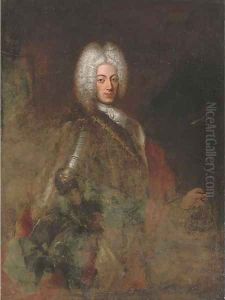Louis De Silvestre II Paintings
Louis de Silvestre II was a prominent French painter of the Baroque era, known for his contributions to the development of portrait and historical painting in the 18th century. Born on June 23, 1675, in Sceaux, France, de Silvestre hailed from a family with artistic roots; his father, Louis de Silvestre I, was also a painter. This environment nurtured his talents from an early age, setting the stage for a distinguished career in the arts.
De Silvestre's early training involved studying under prominent artists of the time, including Charles Le Brun, the leading French painter and art theorist of his era. This tutelage provided him with a strong foundation in the principles of French classical painting, which he would later adapt and expand upon in his own work. Seeking to further his education and exposure to art, de Silvestre traveled extensively throughout Europe, spending significant time in Italy. His experiences in Italy, especially in Rome, were instrumental in shaping his artistic style, exposing him to the works of the Italian masters and the principles of the Renaissance and Baroque movements.
By the early 18th century, de Silvestre had established himself as a painter of renown, attracting the attention of European nobility and royalty. His talent and reputation led him to the court of Augustus II the Strong, Elector of Saxony and King of Poland, where he was appointed as a court painter. This position allowed him to work on a variety of important commissions, including portraits, allegorical scenes, and historical paintings that decorated the royal palaces and estates. His work during this period is noted for its dynamic compositions, vibrant use of color, and the ability to capture the grandeur and elegance of the Baroque court.
De Silvestre's influence extended beyond his own paintings. In 1716, he was appointed director of the Royal Academy of Arts in Dresden, where he played a significant role in the development of the arts in Saxony. Through his leadership and teaching, he nurtured the talents of the next generation of European artists, promoting the values of Baroque art while also encouraging innovation.
Louis de Silvestre II's career was marked by his ability to blend the grandeur of the Baroque style with the emerging sensibilities of the Rococo movement. His legacy is not only in the paintings he left behind but also in his contribution to the cultural and artistic life of early 18th-century Europe. He passed away on April 11, 1760, in Paris, leaving behind a body of work that continues to be celebrated for its artistic merit and historical significance.
